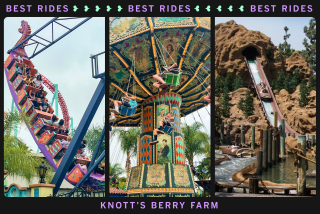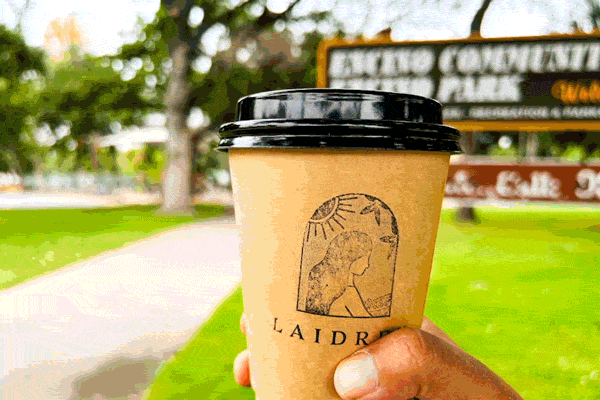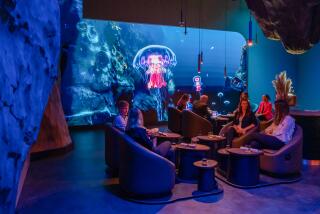Modern Parks Take Child’s Play Seriously : Recreation: The urban gyms of the ‘90s act as havens for families and as places where children can learn.
- Share via
In the beginning, there were metal swings, whirling merry-go-rounds and wooden see-saws that hit the ground with a thump.
In the back-to-nature 1960s and ‘70s, children’s playgrounds switched to pine timbers or telephone poles, and swings were made of recycled tires. In the ‘80s, we learned that some play equipment might be hazardous to our kids’ health.
Enter the urban jungle gym of the ‘90s. Much more than just a place to build sandcastles, the new playland is likely to include exotic mazes, giant covered slides, castles, obstacle courses and a hundred places to hide, seek, stretch--and learn.
It’s bigger--several hundred kids may play there with room to spare--and, designers hope, better for the children. The watchword is safety, but the basic idea is definitely play. The goal is still to challenge youngsters, but with inventive, quality design, not with dangerous forms.
Children growing up in urban environments--and there are more of them these days as the birthrate has climbed to its highest level since the postwar baby boom ended in 1964--are playing in a different world.
Spaces designed for kids to let off steam, stretch their muscles and pick up social skills have become familiar sights not only in grassy public parks but also at day-care centers, in once-vacant inner-city lots and beside fast-food restaurants.
In some neighborhoods they may be rare havens where families can interact. As for schools, public parks and communities, traditional sponsors of children’s playgrounds, they are competing and spending actively for the latest designs.
“In our society, we have eliminated through development and safety issues a lot of places kids have played,” says Susan Goltsman, a partner in the Berkeley design firm of Moore Iacofano Goltsman, creators of play environments.
“You can’t go out in urban areas and find vacant lots and ravines and places to build clubhouses. That’s the kind of stuff that kids do now in playgrounds, though it’s somewhat artificial.”
Playground design is evolving because of several important trends. Part of the problem is development--each year, more woods get chopped down and more creeks get paved over.
A more disturbing problem has been injuries to children sustained while using playground equipment. The Consumer Product Safety Commission is studying playground hazards, and manufacturers have begun to develop safer and more resilient surfacing materials.
To develop this new generation of play structures, designers and early childhood educators have joined forces to create outdoor learning areas with as much care as they traditionally have devoted to indoor spaces.
The new playground may have water fountains, wooden cars with wheels that turn, real trees to climb, specially scaled toddler play areas with benches for parents or care-givers and accessibility for the disabled.
“I call my playgrounds ‘imagination stations,’ ” says Robert Leathers, an architect based in Ithaca, N.Y., who has designed more than 650 playgrounds for communities around the country.
Leathers has major credibility with the pint-size set. He has made guest appearances on “Sesame Street” and “Mister Rogers’ Neighborhood,” and in 1984 he created play areas for the giant pandas at the National Zoo in Washington.
His playgrounds are known for such fantasy elements as towers, castles, rocket ships and elaborate mazes.
Leathers’ most ambitious project, and one of the larger playgrounds in the country, is the Rock River Discovery Park on an acre at the Discovery Center Museum in Rockford, Ill.
Situated 90 miles west of Chicago, the park was built with more than $150,000 raised by the community, more than 20,000 hours of volunteer labor and more than $100,000 worth of donated materials, according to Sarah Wolf, director of the museum.
It offers many innovations of recent playground designs and adds a hands-on approach to science that has become popular in children’s museums.
This playground-cum-science park can accommodate 300 participants at a time. There are 140 settings and structures to be explored, from a cave with stalagmites and stalactites to a weather station to an archeological dig.
“Children and parents alike are expecting an awful lot more from a playground,” says Leathers. “It’s not sufficient to just have a place where kids tear around and get their energy out. Now parents expect places where their children can truly learn.”
According to designers of playground equipment, landscape architects, city and school officials and educators, playgrounds should serve ideally as neighborhood safe havens in the city or as easily accessible after-school and weekend haunts in suburban settings.
The challenge for designers is to devise innovative, safety-first designs that will appeal to children. For communities, the challenge is coming up with the money to pay for building and maintaining the new facilities.
“One of the major problems in the ‘90s is the fact that most of our playgrounds are obsolete,” says Frances Wallach, a Manhattan-based independent consultant in the park and playground field. “They no longer meet any guidelines for safety.”
Until after World War II, playgrounds in America were largely extensions of physical education programs at schools, where kids used climbing structures or did chin-ups.
As American families moved into urban centers over the ensuing decades, childhood educators began collaborating with architects and designers to develop more creative outdoor learning centers.
Today’s state-of-the-art designs are often the products of teams of people, including architects, landscape architects and major manufacturers of playground equipment.
“You can’t just plop a play structure down in the middle of a pile of wood chips,” says Rachel Davis, an architect for the Maryland National Capital Park and Planning Commission Department of Parks. “You have to offer much more.”
Davis and her colleagues, including landscape architect Heidi Sussmann, have watched Maryland’s 2-year-old $200,000 Action Playland at Cabin John Regional Park become a mecca for kids from all jurisdictions.
Instead of individual play structures, Cabin John, which was designed by Sussmann, is nestled in a wooded glen and has a massive, towerlike tree house that is the core of a maze of tube slides, climbing rope bridges and ladders.
The need for playgrounds is being stretched further by the increase of children with two working parents. One of the biggest growth areas for makers of playground equipment is in nurseries, preschools and day-care centers.
By 1995, the mothers of two-thirds of all children under age 5 and three-fourths of all children ages 5 to 13 will be in the labor force, according to projections by the Urban Institute.


